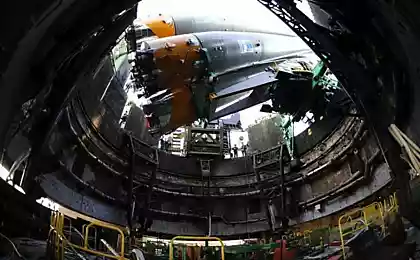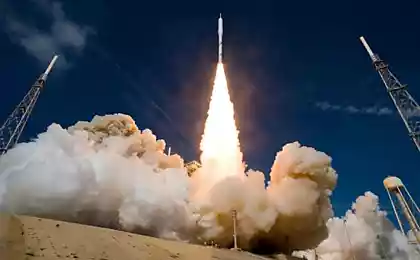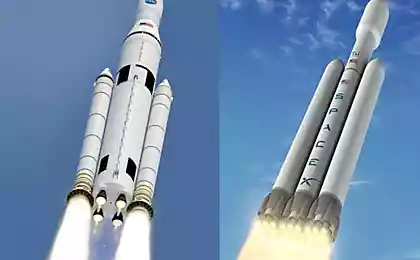1653
News about the "Angara" to "Sea Launch" - why is it important?
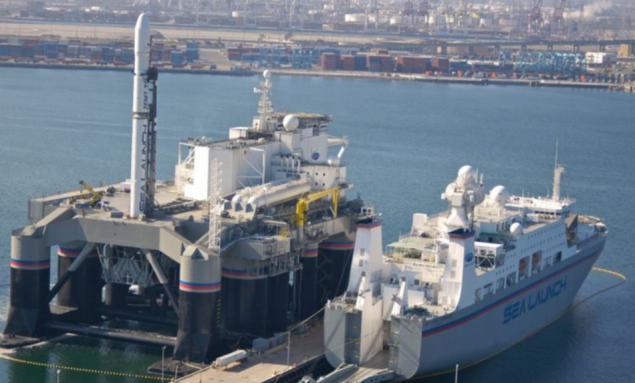
This week is not very noticed was the news of the review in the Russian space industry ideas to use launcher "Angara A-5" to replace the "Zenit-3SL» on the project "Sea Launch". They reflect the difficult process of discussing ideas. First passed Posts that this idea is being discussed. Then there was information that Chief Designer "Angara" said inexpedient this idea . News about the final decision has not yet appeared, try to understand themselves in the pros and cons of this idea.
Background h4> The "Sea Launch" started by today's standards for a long time - in 1993. The idea was to put the carrier rocket "Zenit" to an offshore platform and launch satellites into geostationary orbit from the equator. The benefit was tempting:
- Start from the equator gives the maximum increment of free linear velocity. Earth rotates with an angular velocity of 1 revolution per day, but the linear velocity of rotation is minimal at the poles and a maximum at the equator. As many as 465 m / s is added to the free speed rocket if the launch is carried out at the equator to the east.
- Zero latitude of the equator means no loss to changes in orbital inclination. When starting with an initial inclination of the orbit of the Earth is equal to the latitude of the spaceport. And for the geostationary orbit need zero inclination. Therefore, at the start, for example, from Cape Canaveral, not waste fuel to correct the initial inclination of 28, 5 °. And when you start from Baikonur have to correct as many as 51, 6 ° of the initial inclination of the orbit.
- The launcher "Zenith" was developed in the Soviet Union, with an emphasis on maximum automation of processes and launch preparation of the launch. So do not be looking at a lot of technical difficulties to run it from an offshore platform on which to start the time there was not a single person. 2007 launches were stopped for a year, but in 2008 there were five starts. In 2009, the company announced its bankruptcy. Obviously, despite the rather high starting activity in the economic part of the project there were some problems. As a result, after all the trials in 2010, the company Energia Overseas Limited, a subsidiary of RSC "Energia", received 95% of shares of "Sea Launch". After the bankruptcy launcher activity decreased, the maximum achievement was 3 satellite, launched in 2012. A авария February 2013 stopped launches more than a year.
This h4> Booster "Zenith" - a good missile, but it fatally unlucky. It was developed as a new RN middle class and could replace the family of carrier rockets "Soyuz", including for manned launches, but the USSR collapsed, and the fundamental modernization of the rocket park in 90 years there could be no talk. The collapse of the Soviet co-operation led to the fact that the plants that make one missile, were in different countries and have become dependent on political relations between them. Second, I fear, the final blow of the missile struck the conflict between Russia and Ukraine. Regardless of the results, the carrier rocket motors which are produced in Russia, and tanks - in Ukraine, has no future. In the short term it will not be made accurately and in the long - technology and equipment will be frozen and lost, at best, partially. And the fact that the base of the "Sea Launch" is located in California, even worsens the position of the project in terms of cooling of Russian-American relations.
The combination of economic and political problems led to what I was expecting news of the final closure of the project. That is why the news about a possible replacement launcher for "Angara" seemed so important - it's probably the only chance for the revival of this beautiful project engineering as "Sea Launch". There is also an interesting question - "Angara A-5" noticeably heavier and lifting rocket than the "Zenith". Let's try to calculate how much it will be able to bring tons into geostationary orbit?
This is different GAP h4> Before you start the calculations necessary to briefly talk about what are the ways of launching into geostationary orbit. The main feature of the geostationary orbit is the gravitational perturbations of the Moon. The satellite should have their own engines and fuel capacity to remain at the desired point of standing. Therefore, apart from the direct elimination, when the satellite is derived launch vehicle (sometimes with the help of the upper stage) once the target orbit, there are so-called geosynchronous transfer orbit. In this case, the upper stage completes its work on the highly elliptical orbit and the satellite reaches its point of standing alone in a geostationary orbit.
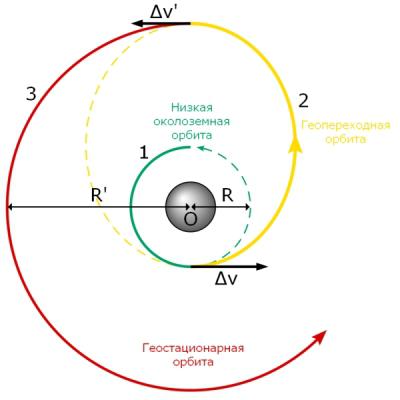
Further, if the final parameters of the geostationary orbit are known (apogee of 35,786 km, perigee of 35,786 km, inclination 0 °), then the initial inclination of all the various spaceports. Therefore, the parameters geosynchronous transfer orbit had different for different countries. More details can be read here , and briefly divided into geosynchronous transfer orbit:
- Conditional "American" (185h35786 km, 27 °) with a delta-V to go to the GSO 1804 m / s and similar to her Chinese and Japanese
- Conditional "European" (200h35786 km 7 °) by delta-V to go to the GSO 1500 m / s.
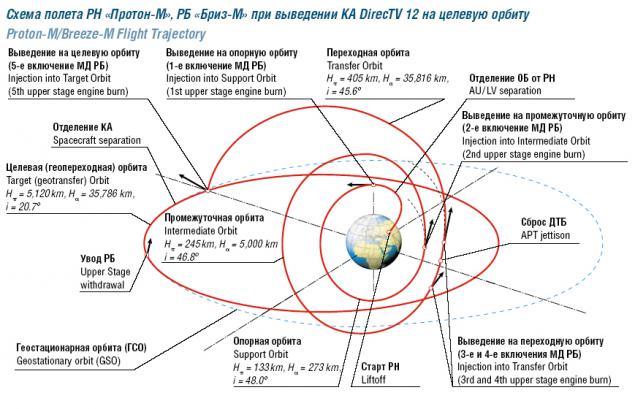
In the case of the satellite with the "Sea Launch" geosynchronous transfer orbit 200h25786 km, 0 ° requires 1477 m / s for the final ascent to GEO.
Settlements h4> According to here this training manual impetus to exit from the orbit of 200x200 km, 0 ° GTO 200h35786 km, 0 ° is 2454 m / s 1477 m / s , and the total delta-V to exit immediately to the GSO will be 3931 m / s «Breeze-M » or developed now KVTK . The masses of empty and full blocks and specific impulse engines is known, so we can calculate the payload by Tsiolkovsky rocket equation:

where:
- V - the final speed (in this case, delta-V)
- I - specific impulse (in m / s)

M 1 sub> is known to us - "Angara A-5" outputs into low Earth orbit 24, 5 t . This assumption for simplicity of calculations - in reality used for removing non-closed orbit with final ascent of the upper stage. Also, do not forget to subtract the weight of the empty upper stage of the M 2 sub>.
The calculations we obtain:
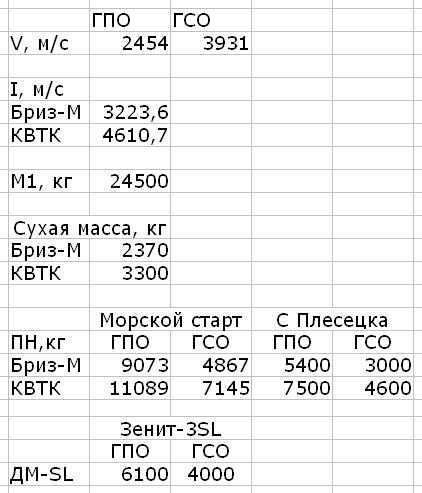
The conclusion is obvious - "Angara" with "Sea Launch" will be able to deduce a half times more than the "Zenith", and with the perspective oxygen-hydrogen unit and KVTK twice.
Pros and Cons h4> At the same time we should not think that there is no argument for closing the "Sea Launch". If you make a list of "pros" and "cons", it will look something like this:
Arguments for adapting "Angara" to "Sea Launch»:
Changing the booster will make it possible to continue the project. «Angara" can be displayed in two to three times more satellites for launch than the "Zenith", increasing revenue from commercial launches. The larger series of carrier rockets, the cheaper they will cost. In addition, additional orders - is adding jobs in high-tech industry. The more complex starting from "Angara", the more flexibility problems and are more likely to further its long and happy operation. Land Base complex is theoretically possible to convert from California, for example, in Brazil. In this case, commercial launches can be combined with cooperation with Brazil in its space program. For the record - Brazil is extremely unlucky with the space program - in 2003 they have developed a rocket exploded on the launch pad, people died. After rejecting the idea of making their own rocket Brazil decided to cooperate with Ukraine and launch rocket "Cyclone-4" from the cosmodrome in Alcantara. The first launch was originally planned in 2013, but to date news on the progress of work can not be heard. The arguments for closing the "Sea Launch»: Stop means the termination of the project costs on him. "The horse died - get off». Adaptation of a new rocket to the already constructed under another rocket launch complex - it is a lot of money and a lot of time. Do not have any factors which categorically prohibit the possibility of such an action, but whether justified high costs? The cost of start-up series "Angara" is not yet known. If the rocket will cost three times as much "Zenith", even if the withdrawal of two satellites make economic sense in the project will not be. Unfortunately, the degree of relevance of these arguments is based on the data that we do not have. So we, the simple part of the viewer, is to follow the news - what will eventually be a "Sea Launch"?
Source: geektimes.ru/post/244432/
How does the phone have seen the future in 1981
Virgin Galactic intends to launch satellites in 2400 to connect to the remote regions









